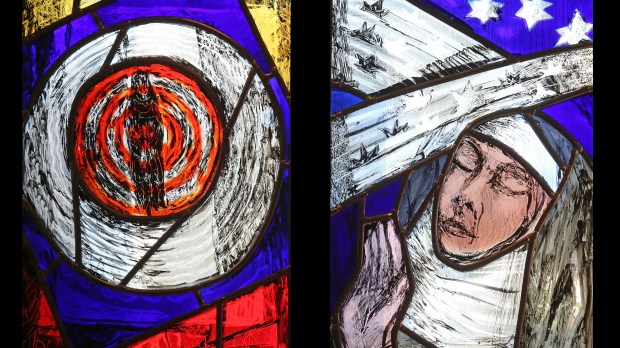It feels as though St. Hildegard of Bingen has taken the Catholic world by storm since her canonization 12 years ago.
Heralded as an icon and a role model for women in particular, this bold and brilliant woman seems to have exploded out of the Middle Ages into the 21st century.
But at least a few people might be wondering, “Why on earth wasn’t she canonized before now? She died in 1179, for crying out loud.” That’s a lag time of 831 years before she was declared a saint.
Her works have been read, studied, and performed throughout all these centuries; surely the Church knew about her before 1978, when the German bishops petitioned that she be declared a Doctor of the Church.
So why wasn’t she canonized already?
There have been a few rumors swirling around about why the Church waited so long to canonize her. Was there some kind of conflict or drama behind the reason she wasn’t canonized?
A few years before her canonization, I learned about St. Hildegard in a college class. I recall my fellow students getting into quite the conversation about why this extraordinary woman wasn’t declared a saint.
Some thought perhaps she was too controversial of a figure, as she was known to pointedly criticize religious and secular leaders she thought were failing in their Christian duties. She especially fiercely opposed the practice of simony.
Others speculated that it was because of that pesky interdict. An interdict is basically a mass excommunication, and Hildegard’s came about when she butted heads with the local bishop shortly before she died. The Catholic World Report shares the story:
In the cemetery of her abbey, she had permitted the burial of a young man who had been excommunicated—she had allowed this because he had been reconciled with the Church and received the sacraments before his death. However, this was unknown to the bishop, who considered the man to have died out of communion with the Church. She refused to remove the body, and, as a result, he placed the monastery under interdict, forbidding the celebration of Mass and singing at the monastery at Bingen. After much pleading, the interdict was lifted a matter of months before Hildegard’s own death. Hildegard died on September 17, 1179.
So with her feast day today, I was curious to find out why exactly she wasn’t canonized for so long. Was there any substance behind the things my classmates and I wondered about all those years ago?
The real reason
It turns out that none of our speculating was true. There wasn’t any conflict or drama or ulterior motive behind St. Hildegard’s exclusion from the official canon. The real reason she wasn’t canonized is something incredibly random, so unexpected it sounds almost silly.
The reason is something that would be an easy fix today, but was an intractable problem in the 1200s. In 1243, the paperwork documenting her cause for canonization was lost en route to Rome. Once lost, it was gone for good.
There were no back-up documents, no extra copy saved on someone’s hard drive. The lost papers had all the information needed to open her cause for canonization. With its loss, her cause fell by the wayside for over 800 years.
Pray Tell reports,
Why on earth was this holy woman never canonized, when in fact Pope Gregory IX had responded positively, in 1228, to a request by the convent of Rupertsberg to inquire into Hildegard’s life with a view toward canonization? Well, to begin with, the men charged with the task of gathering the necessary materials, especially the accounts of witnesses, failed miserably. When late in 1233 they finally dispatched a report to Rome, it lacked fundamental details, e.g., the names of witnesses of Hildegard’s miracles. Pope Gregory then appointed three different men to gather the missing information; these men failed even more grandiosely by, apparently, simply doing nothing. Finally, after a papal inquiry in 1243, a commission provided the necessary details to the initial report — but this detailed documentation simply vanished somewhere between the Rhine valley and Rome. Thus ended the official canonization process of Hildegard of Bingen.
So that’s the real reason: No drama, no scandal, just an incompetent inquiry and the all-important papers lost forever.
As frustrating as this story is to read about, I can’t help but wonder if there’s a certain wisdom behind the timing. The recent canonization of St. Hildegard has coincided perfectly with an era of new leadership for women in the Church.
Perhaps there’s a greater purpose behind those papers getting lost all those centuries ago, as so many of us have been reintroduced to St. Hildegard right when we need her. In fact, Pope Benedict spoke of the timeliness of her canonization:
The teaching of the holy Benedictine nun stands as a beacon for homo viator. Her message appears extraordinarily timely in today’s world, which is especially sensitive to the values that she proposed and lived.
We are grateful for Hildegard’s luminous witness, just as much now as when she lived.
St. Hildegard, pray for us!




